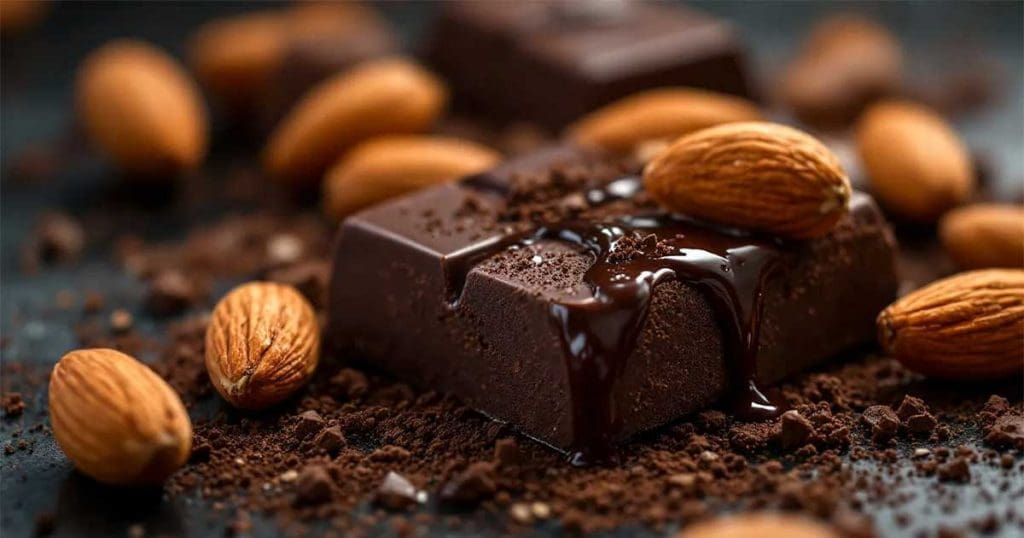
A single batch of fudge once weighed 5,760 pounds—the largest ever made in Ontario, Canada. This massive treat kicks off the perfect story for National Nutty Fudge Day, a celebration of the creamy, nutty delight. May 12 marks the day to savor fudge’s rich history and creative flavors.
From its origins in the 1800s, when “fudge” evolved from the Norman word “fadge” (meaning “to fit”), this treat has become a beloved snack. American composer Cole Porter even had fudge shipped worldwide. Today, nutty fudge blends butter, chocolate, and walnuts into a timeless favorite.
Celebrate National Nutty Fudge Day by trying recipes or hosting a tasting party—because no one can resist the crunch of nuts in every bite.
What is National Nutty Fudge Day?
Every May 12, National Nutty Fudge Day celebrates nutty fudge. It’s a mix of chocolate and nuts like walnuts or pecans. People get to try homemade fudge or enjoy store-bought ones.
It’s a time to share delicious fudge desserts. Whether it’s in family kitchens or candy shops, it’s all about the tradition.

Overview of the Celebration
Celebrate National Nutty Fudge Day by making homemade fudge with nuts. You can try different flavors like peanut butter or almond. It’s fun to experiment.
Hosting a fudge tasting or giving it to neighbors makes it a social event. It’s a day to be creative, whether you bake or just enjoy store-bought treats.
Historical Background
The first fudge recipe was written in 1886 by Emelyn Battersby Hartridge. The word “fudge” comes from “fadge,” an Old French word for “fit together.”
A famous 5,760-pound fudge batch in Ontario shows how popular it is. Even composer Cole Porter loved it so much, he had it shipped all over the world.
Today, National Nutty Fudge Day connects history with fun. It celebrates both the tradition and the new twists in fudge.
How to Celebrate National Nutty Fudge Day
National Nutty Fudge Day on May 12 is a great time to enjoy sweet traditions. You can bake in the kitchen or invite friends over. Try making nutty fudge ideas with walnuts, pecans, or cashews in chocolate. Share your creations online with #NationalNuttyFudgeDay.

“The trick to good homemade fudge is to cook ingredients to the right temperature and cool the mixture properly,” advises Allrecipes. This ensures smooth, firm yet soft squares.
Bake Your Own Nutty Fudge
Learn fudge making tips like using a candy thermometer. It helps reach 237°F for the best texture. Try different recipes, like classic ones with butter or plant-based ones with almond butter.
Add sea salt or pistachios for a unique homemade fudge. Share your baking journey on social media to inspire others!
Host a Fudge Tasting Party
Host a fudge swap where everyone brings their favorite nutty fudge ideas. Play games like “Guess the Nut” or “Sweetest Texture.” Serve fudge with coffee or red wine.
Display your creations on platters with recipe cards. Don’t forget to tag #nuttyfudgeday! For more fun, try to break a record, like Canada’s 5,760-pound fudge batch. Take photos for Instagram.
The History of Fudge
Fudge desserts have a history as intriguing as their smooth texture. Their origins are shrouded in chance and college corridors. No one inventor is credited with its creation. The name “fudge” comes from the Old French word fadge, meaning “to fit,” suggesting it was a happy accident in American culture.
Origins of Fudge
In 1886, Emelyn Battersby Hartridge, a Vassar College student, started a tradition. She made 30 pounds of fudge for a school auction, inspired by a Baltimore relative’s recipe. Around the same time, a caramel maker’s apprentice accidentally created a grainy yet tasty fudge. Both stories highlight that fudge was born from kitchen experiments, not precise lab work.

“The first batch was a hit—so much so that I knew I had to share it,” wrote Hartridge in her 1886 letter, capturing the accidental genius behind fudge’s rise.
Fudge in American Culture
By the 1900s, chocolate fudge was a beloved part of American life. Mackinac Island, Michigan, made fudge-making a spectacle, with shops showing its creation on marble slabs. Even composer Cole Porter loved it so much, he had nine pounds shipped to him every month. Today, homemade fudge recipes are treasured, passed down through generations. Fudge’s journey from kitchen mishaps to vacation treats is as flavorful as its taste.
Popular Variations of Nutty Fudge
Nutty fudge comes in many flavors, from classic to new. It mixes chocolate with nuts for a tasty treat. These are great for gifts or snacks. Let’s look at three special types that show how versatile nutty fudge is.
Peanut Butter Fudge
Peanut butter fudge uses creamy spreads and peanuts for a unique taste. Even though peanuts are legumes, they taste like nuts. Adding sea salt or chocolate swirls adds texture and flavor.
Some recipes mix peanut butter with chocolate fudge for a Reese’s-like taste.
Walnut Fudge
Walnut fudge is loved for its crunchy walnuts in smooth chocolate or vanilla. The mix of crunch and smooth is perfect. Try maple flavors for a New England twist or add crushed walnuts for a pretty touch.
This classic has a long history, even in women’s colleges like Wellesley.
Chocolate Hazelnut Fudge
Chocolate hazelnut fudge is fancy, with cocoa and hazelnuts. Nutella or hazelnut extract add to the flavor. Layer it with dark chocolate or add hazelnuts for texture.
Adding espresso or orange zest makes it even more special. This European-style fudge shows nutty fudge is for everyone.
Health Benefits of Nuts in Fudge
Adding nuts to nutty fudge ideas makes this classic dessert healthier. While delicious fudge desserts are always a treat, nuts add vitamins, minerals, and fiber. This makes them a bit better for you.

Nutritional Value
Nuts like almonds and walnuts bring protein and healthy fats to nutty fudge ideas. A 30g serving of nuts has 4g of protein and 13% of daily fiber. They also give 36% of vitamin E needs.
These nutrients balance out the sugar in delicious fudge desserts. Almonds add magnesium, and walnuts have omega-3s. Even a little bit of nuts makes the fudge taste better and is healthier.
Heart Health Benefits
Nuts have heart-healthy unsaturated fats that may lower LDL cholesterol. Walnuts have omega-3s, and pistachios have plant sterols. These help manage cholesterol.
Though fudge has sugar and butter, nuts’ antioxidants and fiber make it a better choice. Celebrate National Nutty Fudge Day with recipes like cashew or pecan fudge. Enjoy a treat that’s sweet and a bit healthy.
Delicious Nutty Fudge Recipes to Try
Make National Nutty Fudge Day special with these simple fudge recipes. They’re perfect for both experienced bakers and beginners. These homemade fudge ideas are sure to be a hit.
“Patience and precise timing are the secret to silky fudge.” – Master Confectioner, Candy Arts Institute
Classic Nutty Fudge Recipe
Begin with Challenge Butter and semisweet chocolate chips (33% cocoa) for a rich taste. Mix butter, chocolate, and vanilla in a bowl. Boil a sugar mix with marshmallows until it hits 238°F, using a candy thermometer.
Pour the sugar mix over the chocolate, stir until it shines, then add toasted walnuts. Chill until it’s set. Each piece has 180 kcal, great for sharing with 36 people. Keep it fresh in an airtight container for up to 2 weeks at room temperature.
No-Bake Nutty Fudge Recipe
Try this homemade fudge without using the stove. Mix sweetened condensed milk, white chocolate, and nuts like pecans or pistachios. Microwave in 30-second bursts until it’s smooth, then add extracts or dried fruits.
Cool it at room temperature before cutting. Add a twist with peppermint or almond extract. This fudge stays fresh for 1 month in the fridge or 3 months frozen.
For fudge making tips, toast nuts lightly for extra flavor. Use a silicone mat to prevent sticking. Celebrate May 12th with these recipes and enjoy the delicious results!
Fun Facts About Fudge
There’s a world of fun facts about fudge that make National Nutty Fudge Day even more special. Let’s explore some surprising details that add to the joy of this day.
National Fudge Day vs. National Nutty Fudge Day
National Nutty Fudge Day is on May 12 and focuses on fudge with nuts like chocolate fudge with walnuts or pecans. On the other hand, National Fudge Day on June 16 celebrates all kinds of fudge. This includes unique fudge flavors like mint and classic recipes.
To celebrate National Nutty Fudge Day, you could add almonds to your fudge. Or, visit places like Vermont’s Ben & Bill’s Fudge for a real treat.
Interesting Fudge Trivia
The biggest fudge slab ever made weighed 5,760 pounds and was made in Ontario. It shows that big flavors need big efforts. Composer Cole Porter loved fudge so much, he had 9 pounds shipped to him every month.
Science is also key in making fudge. The perfect temperature for fudge is 237–239°F. This ensures it’s smooth and doesn’t crystallize. And did you know “fudge” comes from “fadge,” an old term for a bad job? Today, it’s a culinary delight!
Join the Conversation: Share Your Fudge Creations
Sharing nutty fudge ideas is a great way to celebrate National Nutty Fudge Day. Whether you make peanut butter fudge or try walnut varieties, your creations have a story to tell. Here’s how to spread the joy of fudge beyond just eating it.
Engage on Social Media
Take pictures of your fudge and use #NationalNuttyFudgeDay. Write fun captions like “Fudge is my love language!” or “Life is better with a little fudge on the side!” Use #FudgeLovers to meet other fans. Share videos of making fudge or compare homemade to store-bought.
Tag brands like See’s Candies or local shops like Vermont Fudge Company. If you share a peanut butter fudge recipe, add #ChocolateFudge for more views.
Participate in Fudge-Themed Events
Look for fudge festivals in places like Michigan’s Mackinac Island or Colorado’s Rocky Mountain Chocolate Factory. Host a “fudge swap” with friends or a tasting to pick the best walnut or almond fudge. Local bakeries like The Fudge Factory in Hershey, PA, or Sweet Street Desserts often have classes.
Turn your kitchen into a mini-event. Host a “guess the nut” game with dark chocolate hazelnut fudge. Every bite shared keeps the tradition alive.

![Black Bean Chocolate Cake [recipe]](https://b3860431.smushcdn.com/3860431/wp-content/uploads/2024/04/Black-Bean-Cake-FB-1024x538.jpg?lossy=2&strip=1&webp=1)

Facebook Comments